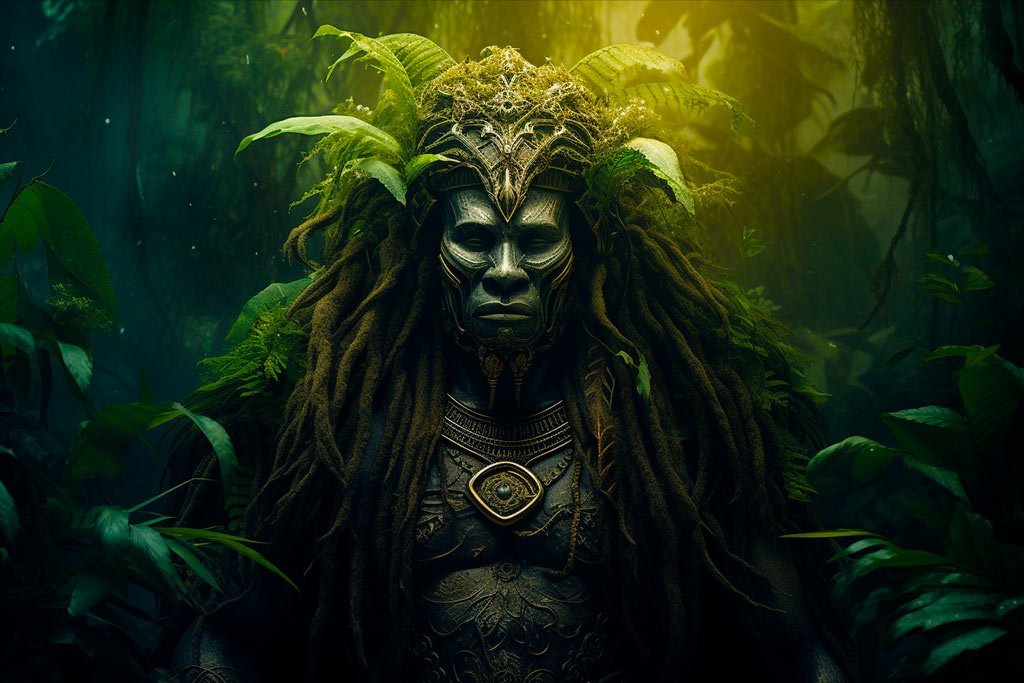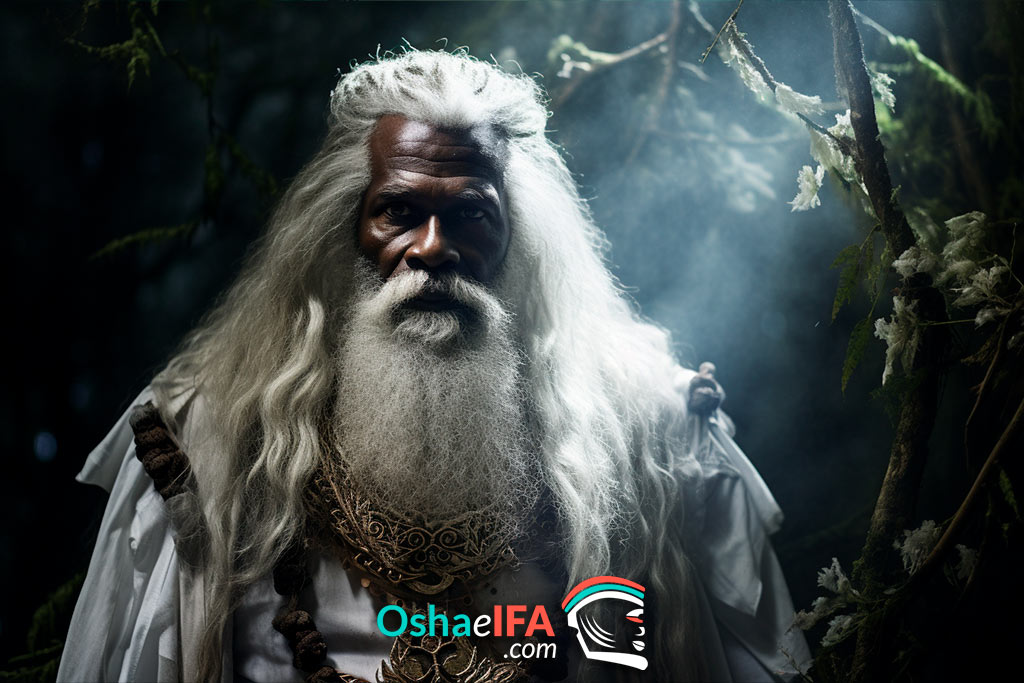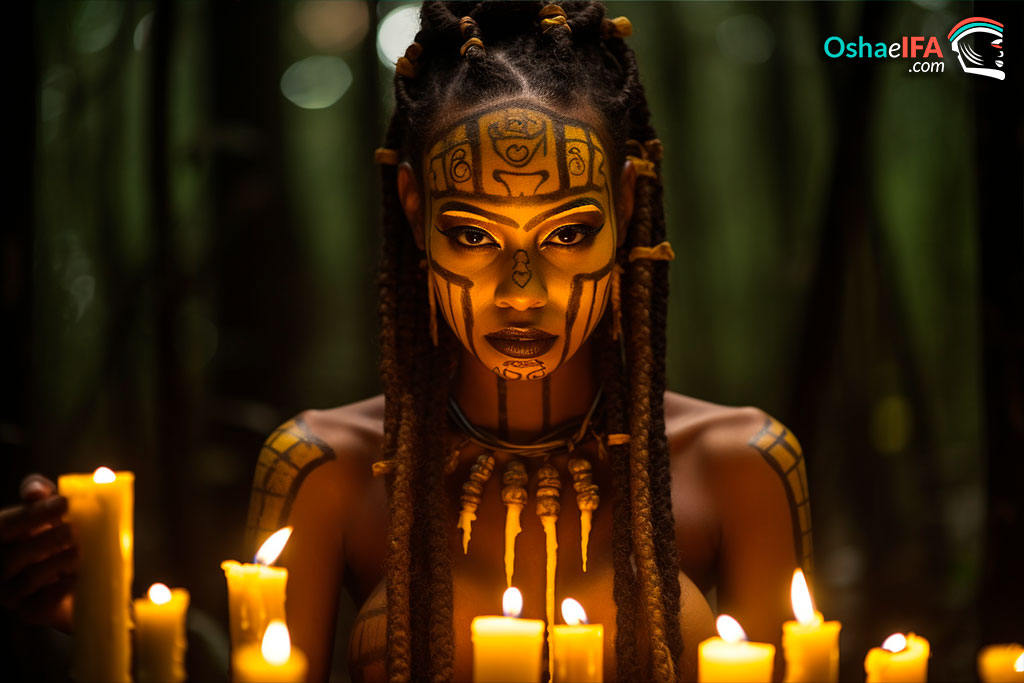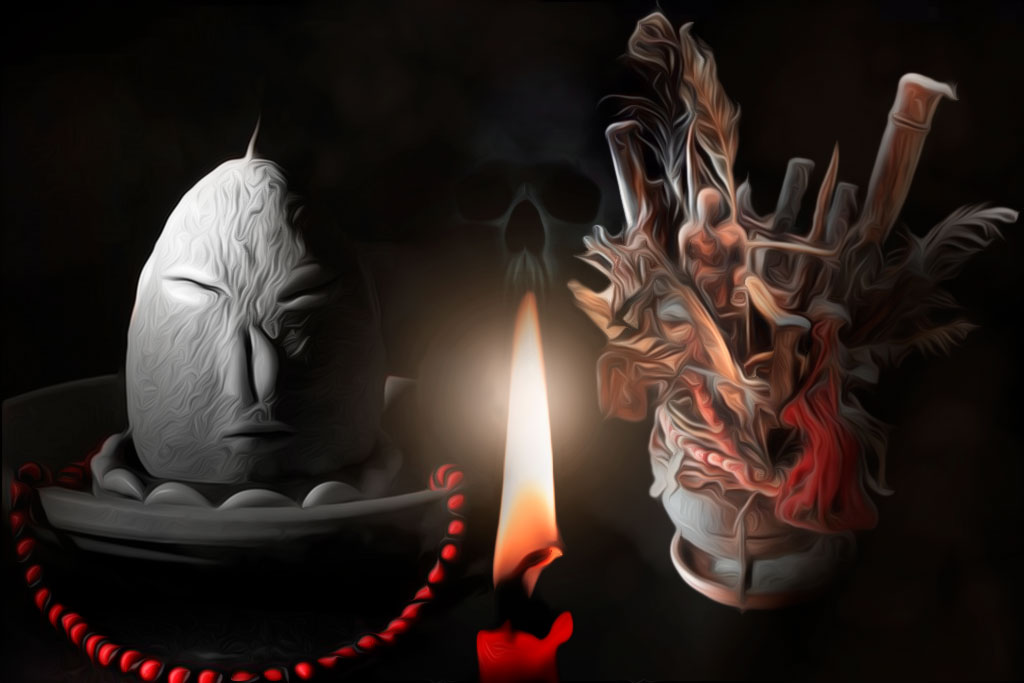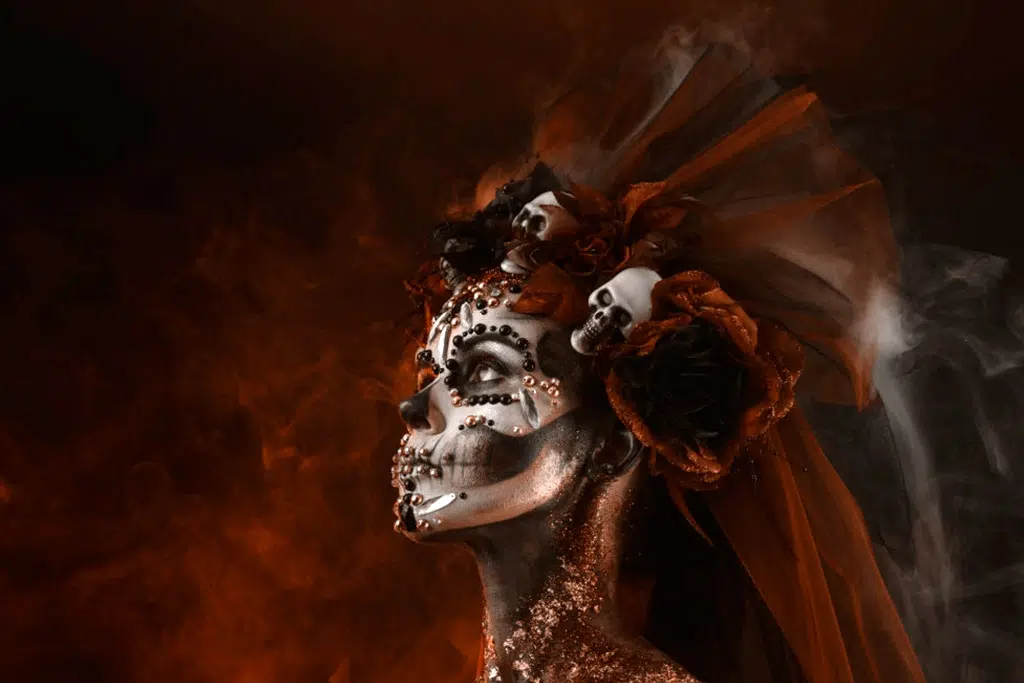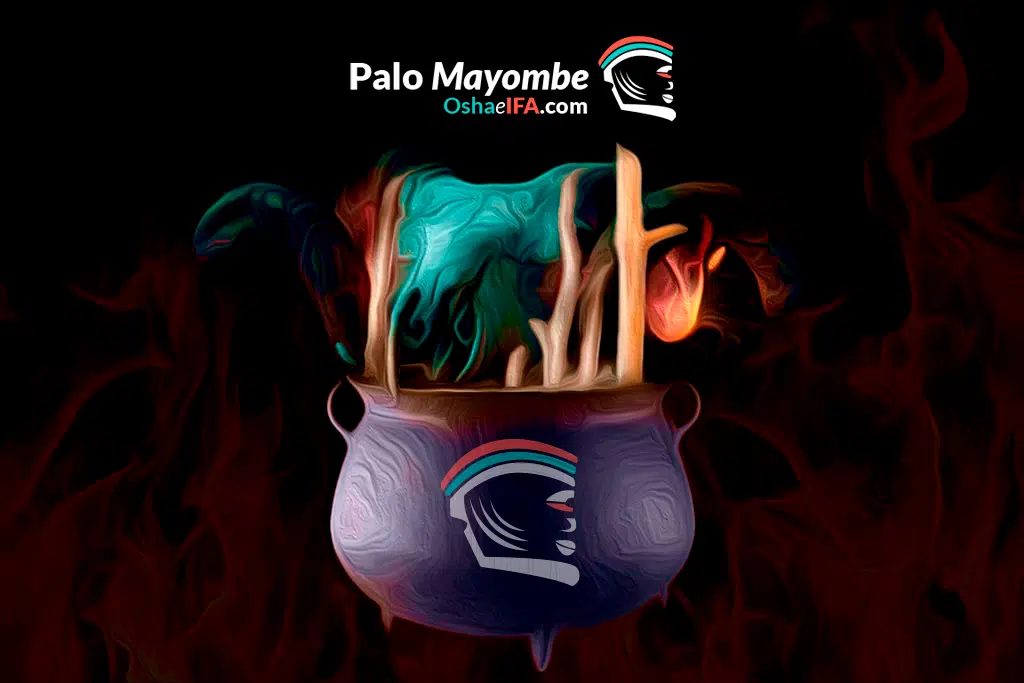Zarabanda: The warrior spirit of Palo Mayombe
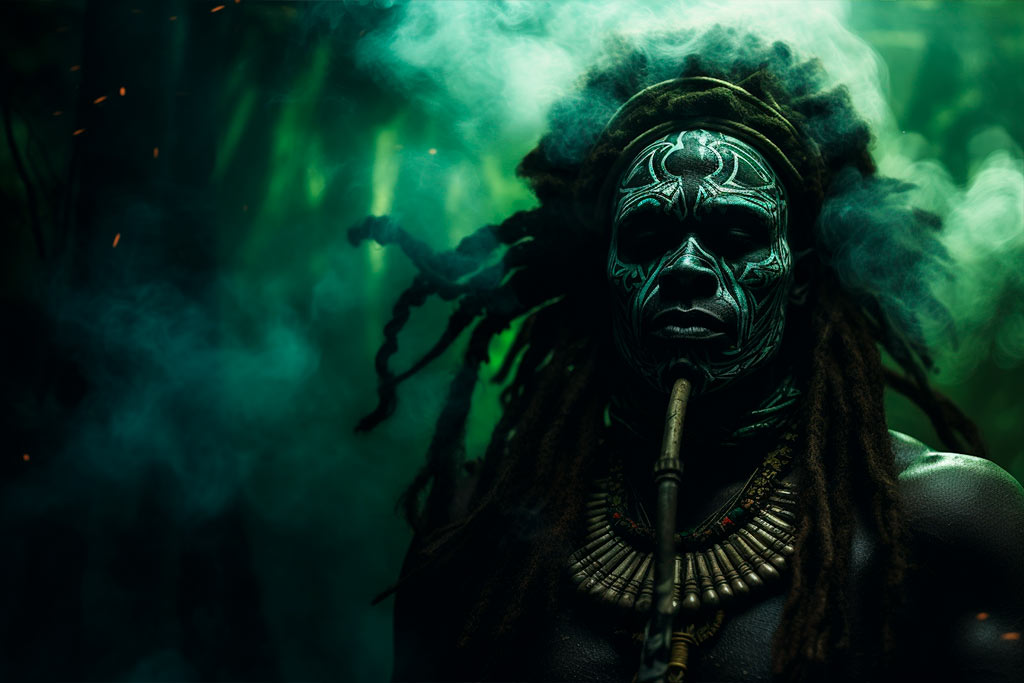
Zarabanda is considered one of the most powerful and respected mpungos of Palo Mayombe, playing a crucial role in the rituals and spiritual practices of his followers. He is revered as the deity of war, strength, and protection. He is credited with dominance over the difficult and dangerous paths of life, being invoked to provide strength and courage in the face of adversity.
Who is Zarabanda?
Also known under the names of: Viento Malo and Cabo en Guerra, Zarabanda son Briyumba is a mpungo of great hierarchy that occupies a prominent place in the spiritual pantheon of Palo Mayombe. He is a powerful ally and protector, whose presence brings strength, courage, and guidance to those who honor him with reverence and faith. His influence on the lives of his followers is deeply significant, providing a valuable spiritual connection on the path to self-improvement and prosperity.
He is one of the four Nkisis called "the Warriors". He stands out for his fierce and determined nature, but also for his wisdom and justice. He is depicted with iron tools, such as machetes and swords, symbolizing his might in battle and his ability to cut through any obstacle in the way. In addition, this means that he is present in any place where there is iron, so his energy is part of all the Ngangas, since most of them are mounted on a metal cauldron.

Zarabanda is a spirit that does not tolerate injustice and acts as a tireless defender of those who invoke it with sincerity and respect. He is also known for his ability to open paths and remove obstacles, allowing his devotees to advance towards his goals and objectives. He is invoked to overcome blockages and difficulties, and to attract good fortune and success in life.
In addition, he has power over bloodshed, revenge and darkness. It is said that he accepts the children of Watariamba as his own children. His ability to defend his protégés is so great that, in most cases, even the most malevolent and knowledgeable priests prefer to avoid going to war with their children.
Attributes and Characteristics of Zarabanda
Colours
The colors with which Zarabanda is identified are: green, black and coral. The color green and the color black have a deep and symbolic spiritual meaning in relation to this mpungo within the tradition of Palo Mayombe.
Green represents nature, life and hope. It is a color associated with healing, renewal and growth. In the context of Zarabanda, the color green symbolizes the connection to the earth and nature, reflecting its role as mpungo of strength and protection. Green is believed to represent life energy and Zarabanda's ability to grant his followers strength and stamina. In addition, the green color is linked to Zarabanda's ability to open paths and remove obstacles, allowing life to flourish and prosper.
On the other hand, the color black represents the mystery, the ancestral wisdom and the connection with the spiritual world. In the context of Zarabanda, the color black symbolizes his power and dominance over the darker aspects of existence, such as war and occult forces. Black is also associated with protection, as it is believed to be a fearless and fierce defender who can face any danger with determination. In addition, the color black represents Zarabanda's ability to face and transform negativity and adverse energies, thus protecting its followers from harmful influences.
Taken together, the colors green and black in relation to the mpungo Zarabanda evoke an image of power, protection, and connection to nature and the spiritual world. They represent the strength and courage of this deity, as well as her ability to heal and open paths to growth and success. These colors symbolize the vital energy and the active presence of this deity in the lives of her devotees, providing them with guidance, protection and strength to face life's challenges with confidence and determination.
your numbers
In the tradition of Mayombe stick, the numbers 3 and 7 are the digits that are related to Zarabanda. Both symbolize his triple nature and his spiritual power and wisdom. They represent the protection, strength and healing that Zarabanda grants to those who worship him, as well as his deep knowledge and his ability to provide guidance and guidance in the lives of his devotees. These numbers also suggest the perfection and completeness of Sarabanda as a spiritual entity, and his crucial role as guardian and defender on the spiritual path of those who invoke him with devotion and respect.
Herbs
Lemongrass, chicken foot, rooster bone, mimosa, immortelle, flower of Jericho, rosemary, pine nut, rompe saraguey, purple basil, ebony. Palo: Carob.
Zarabanda syncretism in different religions

Syncretism refers to the convergence and adaptation of African spiritual entities with figures from the Catholic pantheon, a process that took place during the colonial era in Latin America. With respect to Zarabanda there are two syncretisms that are more significant. It is related to the Orisha of the Yoruba pantheon Oggun and to the Catholic saints San Pedro and San Juan Bautista.
Zarabanda, is revered in Palo Mayombe for his strength and power, from here he shares essential features with the orisha Oggun. Both are deities associated with metals, technology, warfare, and protection. In syncretism, a symbolic and spiritual fusion occurs that highlights the duality and interconnection of these two figures, thus transcending cultural and religious barriers.
The link between Zarabanda and Ogun reveals a subtle synergy in which its characteristics intertwine to enrich the understanding and worship of both traditions. In this syncretism, Zarabanda brings his strength, audacity and resolution, while Oggun brings his ability to work iron and metal, thus representing transformation and spiritual forging.
The relationship with that Orisha is what gives rise to its syncretism with San Pedro, since shared elements are presented that highlight their role as guardians and protectors. Saint Peter, as the gatekeeper of the heavenly gates, shares with Zarabanda the role of custodian and protector of the roads. This spiritual encounter highlights a deep connection between both traditions and the adaptability of the cult of Palo Mayombe.
As for its relationship with Saint John the Baptist, it is born from the use of certain elements in common. Both use animal skins, which demonstrates their connection with elements of nature and also use the figure of the cross as a reference. These elements are intertwined to give rise to an image that transcends religious and cultural borders.
The syncretism between Zarabanda, Oggun, San Pedro and San Juan Bautista, is a testimony of the spiritual richness that arises when different religious beliefs and practices converge. It is an example of how human beings find ways to preserve and honor their ancestral traditions, even in a new religious context.
For followers of Palo Mayombe, this syncretism represents an opportunity to deepen their understanding and worship of their deities, while finding reference points in other religious traditions. It is a path towards unity and the harmonious coexistence of diverse spiritual expressions.
How is Zarabanda cared for?
The most common offerings offered to this mpumgo are: green bananas, African yams, rum, brandy, and strong liquors; cigars, candles, black pepper, and machetes. Their offerings are usually taken to the train tracks. The following are immolated: roosters, jutias, calves, goats, turtles and rams.
Also, you can be offered a drink called "chamba". The chamba is the sacred liquid of Palo. There are many ways to prepare it. In general, it is made from herbs such as elderberry, marquise, lilies, mango, clove pig, among others. Added: spices, purple onions, chili pepper, and some elements to be considered by the officiant. A few drops of: rainwater, collected especially during the first rain of May, river water, seawater, holy water from a Catholic church and brandy are also placed on it.
This mixture has a very particular preparation and must be buried or kept in the shade for at least 7 days before its use, to stimulate the concentration of its ingredients.
What is being asked of you?
We know that each devotee may have their own personal requests that they make to Zarabanda in a particular way, according to their individual needs and circumstances. The relationship with this spiritual entity is based on faith, trust and mutual respect, and through offerings and ceremonies, a deep connection is established that provides support and guidance in the life of the believer. However, his devotees often ask him:
- Protection against enemies and negative energies.
- Strength and courage to face difficult situations.
- Help to solve legal and judicial problems.
- Support in labor and professional matters.
- Physical and emotional healing.
- Attraction of good luck and success in projects.
- Liberation of ties and obstacles in life.
- Wisdom and mental clarity to make important decisions.
- Spiritual strength and connection with the divine.
- Support in overcoming addictions and bad habits.
- Protection for home and family.
- Guide on the path of personal and spiritual transformation.
- Help to find solutions to economic problems.
- Promote the development of skills and talents.
- Inner peace and harmony in personal relationships.
How are the children of Zarabanda?
Zarabanda children are characterized by having a strong temperament, they are unpredictable and have a difficult treatment. They do not forgive any kind of offenses and it is said that they are extremely spiteful.
On the other hand, they are very persistent people, they do not faint under any circumstance and remain firm until they achieve the objectives they have set for themselves. They are born leaders. Although they like fights and confrontations, they are good-hearted and develop the ability to protect those around them. They are very skilled with manual work such as blacksmithing and all activities that are related to metals.
History of Zarabanda
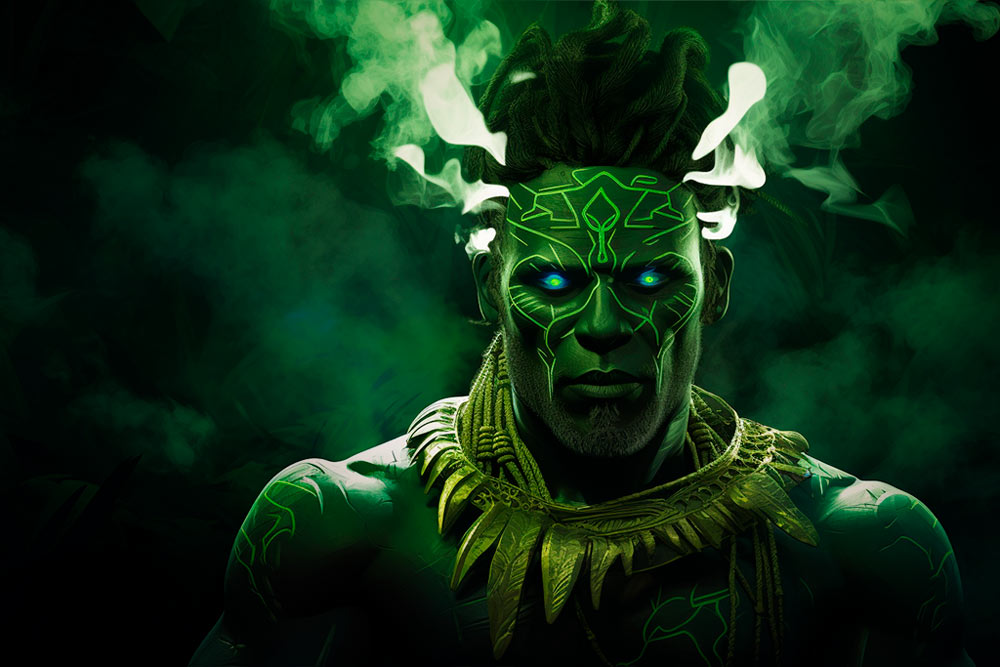
It tells a very old conga story that a Mpungo named Zarabanda was entrusted by Nsambia with the mission of looking for a new ntoto (land) to inhabit, since Nsambia wanted to retire to rest. He set out in search of the new ntoto taking with him Kiyumba embuao (head of a black dog), malango (aguardiente), zusundango (tobacco) and an inkiko (rooster).
First he went in search of advice to the ntoto of Mama ungundo (la Ceiba) who was his yayi (mother) leaving him inkiko and taro as an offering. Mama Ungundo gives him her blessing, but also a very valuable secret, which in time would earn her recognition before Nsambia.
Mama ungundo asks him to kneel down and extend his hands, handing her a güiro where the foundation of gurrufinda (God of the mountains) was, making the three of them a pact that they sealed with Menga (blood) from a black inkiko. Gurrufinda in turn gives Zarabanda 3 mataris Nsasi (lightning stones), which would help them in their search task and protect them. He also gives him endless secrets of the mountain, becoming the zarabanda from that moment guardian of the mountain.
Entering Zarabanda into unknown lands, he stumbles upon ngó (the tiger), between them a great battle is fought, having zarabanda to kill the tiger, he decapitates it, keeping the quiyumba as a trophy, the entrails are buried, with the skin and claws a new garment was made. But, mayombe witnesses everything that happened and tells Siete Rayos that he owned the tiger and those lands.
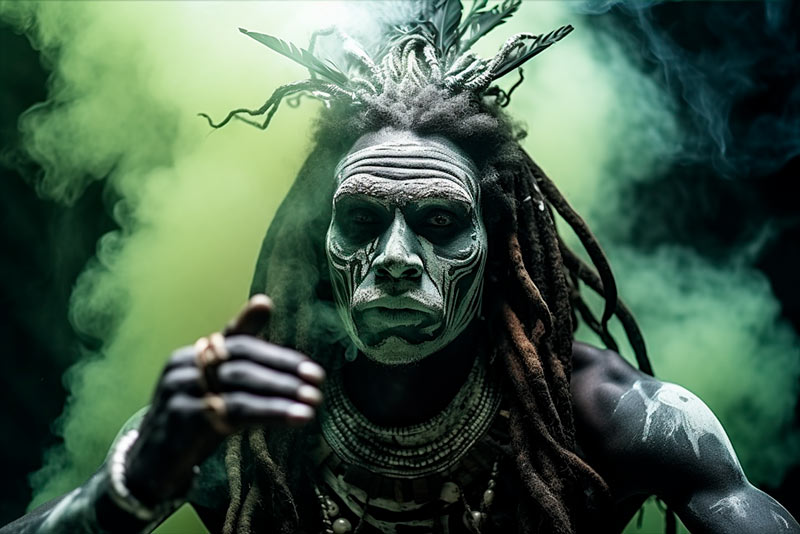
Nsasi comes out in his path and confronts him blaming him for the death of the tiger, Zarabanda explained what happened. Seven Rays did not understand how they had killed the tiger being so strong. In Sarabanda's hands there was only a güiro and 3 stones, but upon seeing them, Siete Rayos immediately understood that it was Tata Gurrufinda, his great brother and adviser. Siete Rayos questions him about the güiro and the 3 stones and he explains everything that happened. Zarabanda and Siete Rayos agree and decide to respect each other. They bury the kiyumba of ngó and together they sang a mambo for the rest of ngó. Siete Rayos teaches Zarabanda the secret of fire. From that moment a great brotherhood is formed between these two Mpungos.
Tired, Zarabanda decides to go to the river to drink water, in this he gets a beautiful and beautiful moana (woman), like he had never seen before. She asks him: How did you enter the lands of Ngó and Nsasi and are you still alive? He tells her what he lived through and how he ended up in a great pact. This beautiful woman was Mama Chola, who gives her water to drink from her munanzo that quickly quenches her thirst. She is she gives him 5 stones from the river that would serve as reinforcement to her magical güiro, and teaches him her path, warning him that it was long and dangerous.
Zarabanda continues his journey, but when he goes up the hill he meets a very old Tata, who greets him when he sees him and says: you must be Zarabanda, the chosen one from Nsambia. Astonished Sarabanda asks: Who are you? The old man answers. I am Earth Tremble, in charge of bringing peace and tranquility to this nation. Earth trembles, hands him a large white matari with a cane. This will serve as reinforcement and the cane to support you. Go your way and go with my blessing.
Later, Zarabanda finds herself with a gigantic maja (snake), and falls prey to fear, but she tells him: -You are Zarabanda, son of Mama Ungundo, who carries the secrets of Gurrufinda and what a pact with the great Nsasi. Follow me, Mama Kalunga wants to see you.
Sarabanda arrives at the ntoto of Madre de agua, who welcomes her. «You have shown great courage and responsibility», Mother of Water tells her, «I am Siete Sayas, Mama Kalunga, Mother of Water, Baluande, Owner of the Four Winds, Vira Vira. I give you this shell and 7 precious stones that will serve as reinforcement and count on my power and the strength of my waters. Take the pestle, it will serve as your guardian and messenger.
Continuing with his tour, he fell ill. So strong was the breakdown that she could not get up; crawling to the desert, where he meets a stinky old man. When taking him in his arms, Zarabanda faints. When he wakes up, he is in campofinda, he is received by a woman who had a kiyumba for her head, surrounded by many nfumbes (dead). The woman identifies herself as Yaya Kenwe, Centella Ndoky, Mariwanga, owner and mistress of the wind and death, the power of the wind and the force of the spark. That she, along with all her secrets, will make him an invincible warrior.
Zarabanda retires, bowing to him. On the way out of Campo Santo he meets the old man again, – thank you for having helped me, Zarabanda tells him. - I haven't finished, the old man answers; and he takes out of a jute bag: grains and bread, with which he cleans it. I am Tata Funde, Punga Fútila, Coballende, Pata Nyaga, god of diseases, mayombe messenger, campofinda goalkeeper. He gives Sarabanda a güiro, in whose content he had sticks, earth and stones, adorned with kiyumba of dyed aura. – What I give you is the complement of your forces with which you will be able to cure and ward off death to those who do not correspond to it.
Finally, Zarabanda sets out and reaches a large point, but it was unknown territory, having to use all the reinforcements and powers received during the journey. Upon entering this new land, he finds himself with three different entrances, confused as to which is the correct path, intones a mambo:
"Nsala malekum, malekum nsala
It goes with a license of 4 winds,
It is licensed by nsusu mayimbe,
kiyumba ntoto that I nsala.
what a way that loses my bargain,
you are true
open wirindinga.
Immediately, a black matari with four different faces sprouts from the earth, I am nkuyo, world star, guardian of campofinda, messenger of Nsambia, there is no Tata or Yaya to tie me up. I myself am life, I myself am death. Zarabanda offers him Malango (aguardiente) and says: – If you are a messenger from Nsambia, show me the way, and if there is a malembo pe mañunga, kinbisi kimbansa. You open the way that I overcome the bad. Sambiampungo from heaven sends all his children to this new child, naming Zarabanda King, acknowledging before everyone that, thanks to his great heart and intelligence, he was able to overcome all obstacles.
This story tells how zarabanda became king in the mayombe stick. Foundation of great strength, since, in it, the secrets of nature are locked up. In it, there is a segment of all the Mpungos, such as: Lucero Mundo, Madre de Agua, Mama Chola, Centella, Siete Rayos and Tiembla Tierra.
Zarabanda Signature
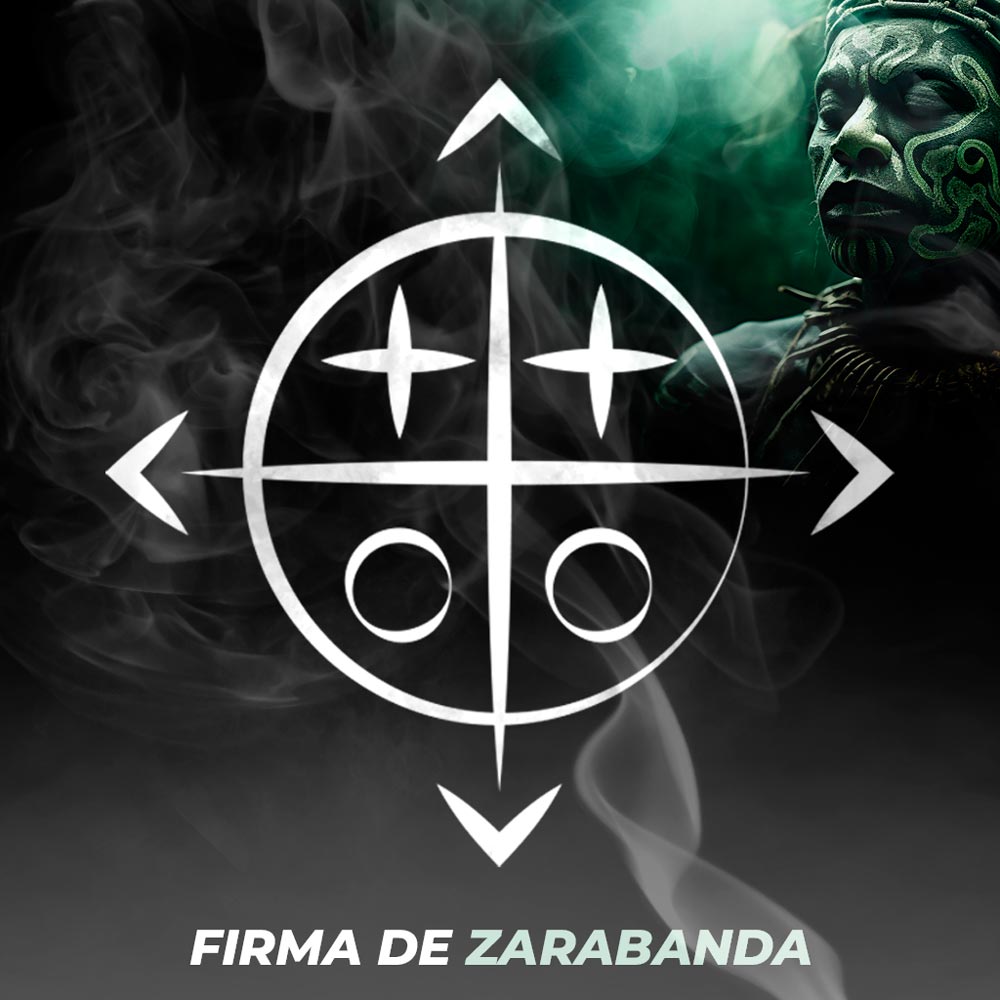
This signature is one of the fundamentals of this mpungo. Each symbol that integrates it has a spiritual meaning and represents specific aspects of mpungo and its influence on the lives of its devotees:
- The cross: it is a symbol universally associated with protection and connection with the divine. In Zarabanda's signature, the cross represents the power and protective presence of the mpungo. It also symbolizes the intersection between the spiritual world and the material world, showing Zarabanda's ability to intervene and act on both planes.
- The arrows: they are symbols of power, speed and strength. In the signature of this mpungo, the arrows represent your warrior nature and your ability to face and overcome any obstacle or adversity. They symbolize Zarabanda's quick and effective action, offering protection in the four cardinal points and freeing his followers from difficult situations.
- The small crosses: like the central cross, they represent protection and connection with the divine. It is a symbol of balance and harmony. It also reflects the influence of Zarabanda in different aspects of the life of his devotees, offering guidance and protection in all areas.
- The central circle: it is a symbol of unity and totality. In Zarabanda's signature, the circle represents the world, and the complete and perfect nature of the mpungo, reflecting its spiritual power and its ability to encompass all dimensions of existence. It also symbolizes the cycle of life and death, showing Zarabanda's ability to protect and guide his followers in all stages of life.
- Small Circles: These symbols represent protection and defense at different levels. Likewise, the largest circle symbolizes the global and complete protection of this deity, while the inner circle represents a more specific and close protection. Together these circles reflect the encompassing and effective influence of Zarabanda.
- Taken together, all these symbols symbolize his protective nature, his spiritual power, and his ability to make his followers achieve their goals in life.
Foundation or Nganga de Zarabanda

It is known that this mpungo was founded, that is, it took the form of nkisi for the first time, in Cuba at the end of the XNUMXth century and its cult spread throughout the island in the first half of the XNUMXth century with the rise of what we know like the Briyumba Rule. This origin goes back to the slaves coming from the Vili ethnic territories, on the West African coast, who arrived in Cuban territory in those years.
The Zarabanda garment is one of the most adored and respected in the various conga rules. It is a foundation that instills great respect and is greatly feared by believers and practitioners of palo mayombe. It is said that within Zarabanda reside some secrets of the 4 winds, ngurunfinda and the stars. These secrets have the purpose or objective of reinforcing Zarabanda and its field of action.
Roads
- Premañongo: he is the goalkeeper of the mountain.
- Seven Pack: is the owner of the stars.
- Win Battle: is the owner of wars.
- Abraca Mundo: is the one who eats on the firm mountain.
- Zarabanda Ceja Monte: he lives on the corner of the seventh door of the mountain.
- Short Lima: it is the one of the good Quiyumba and candongo that lives in the mills.
- Sun Sun Vira Vira: is the one who eats at the foot of the palm.
- vititi congo: he is the owner of the empaca menso.
- Sarabanda Ndoki Yaya: he is the owner of the fortresses.
- Executioner Enfinda: he is the one who eats black dog.
- Get Pawn: is the one that eats in swampy places.
- Ego la Finda: is the one who eats in one of the four corners of the cemetery.
- Siete Loma: is the one who lives in the thorn trees.
- Seven Door: is the one that eats cat in the ceiba.
- Guinda Vela: is the one who eats in destroyed or ruined houses.
- Seven League: is the one that eats on the shores of the lagoons.
- Zarabanda Patasueno: is the one who eats in the dark.
- Busca Mundo: he is the protector of the blood sick.
- Insunso Carire: he is the one who eats when there are no women present.
- Da Lebankita: he is the one who eats deer, balsino cat and pig at twelve at night.
- Gierve Gierve: he is the one who eats bull, owl and is the only one who eats snapper.

